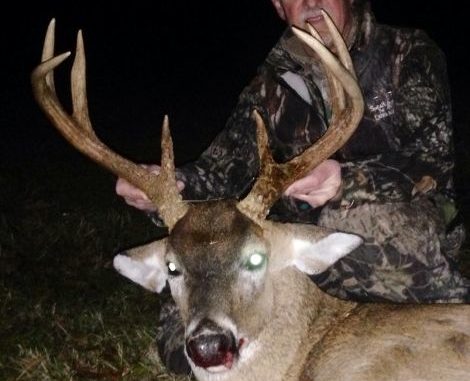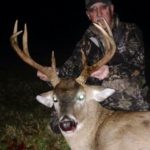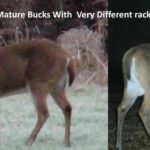
Experience makes decisions easier
When selecting a monthly topic for Happy Trails, my usual goal is to write about something that will allow me to share the knowledge and experience that I have gained through more than 40 years of chasing whitetails. I also like to provoke thought and discussion about certain topics and issues.
To that end, allow me this month to relate to you a story about a successful hunt that occurred this past season, illustrating the importance of watching and studying buck behavior and becoming proficient in aging bucks on the hoof.
A study of buck behavior during the rut can be found in books, but it is better gained over time through experience in the field with your own eyes. Let’s also not forget what can be learned from close observation of your growing archive of trail camera photos. Mastering the art of quickly and accurately determining a buck’s age has never been more valuable to a whitetail hunter than it is today with buck age harvest limits and minimums becoming more and more common.
During this just-ended season our web of trail cameras identified and focused our attention on two or three fully mature bucks with bragging-size racks. Much thought and boot leather was expended by late December in their pursuit, to no avail.
On Jan. 2, my son and grandson came up to the farm to hunt, and as usual we carefully deliberated about where to go for the afternoon hunt, taking into account the cold front that had just passed and the resulting blustery north wind that was blowing. We also discussed what the latest batch of trail camera photos had shown regarding the rut and buck movement.
I gave them first choice of stand locations, and they decided to go to a box stand in a large field that overlooked good cover and several perimeter food plots. My stand location for the afternoon needed to be far enough away and cross wind from them so that I would not negatively impact their hunt.
Some head scratching and a little time spent staring at an aerial photo of our stand locations told me that my best bet might be to take a stealthy, circuitous route to a covered tripod stand that is situated at the south end of a northeast trending, long and narrow food plot.
After gathering my gear and setting off from the camp, I carefully stalked my way to the plot and, as quietly as possible, climbed up the ladder and got into position.
As I unzipped the windows of the fabric stand cover, I was met with a gusting blast of cold air blowing straight down the field toward me. Although the wind direction was almost perfect for the setup, I quickly became aware that the alternating gusts of cold wind were rocking the metal tripod struts, and a long shot could become a challenge.
As we usually do, we had decided to keep in touch between our two stand sites by way of our iPhones using text messaging. What I did not anticipate, though, was the fact that on this particular afternoon with the prevailing high winds I was not going to have good signal coverage.
As I alternately watched the food plot and fiddled with my phone, I began to notice that one minute I would have a couple of bars of 4G service and then the next my phone display would say “No Service” or “SEARCHING.” This was not the first time that this had happened during the season, so I said “Phooey on it,” and put the phone away and concentrated on watching the food plot.
After a while, a lone doe walked out and fed briefly before moving on into the brush and disappearing. A short time later, as I sat there contentedly enjoying the sights and sounds of a beautiful but cold winter afternoon, another doe walked out and began feeding on the lush, tender shoots of oats and wheat in the plot.
Pulling up my binoculars to watch her more closely, I noticed movement at the edge of the brush where she had just walked out. Panning the glasses over slightly to focus in on what I thought would be a follow-up doe, I instead saw thick antler beams suddenly materialize.
I did not recognize this buck at all, so a quick but accurate judgment of whether or not to harvest him was needed. As the buck slowly walked out, I quickly ran through my mental “aging-on-the-hoof” checklist. The buck had an impressive set of heavy, 8-point antlers that carried their mass all the way to the tips of each beam, a fairly clear indication that this buck was approaching or was already at 100 percent of his ultimate antler potential. With my personal goal being to hunt and harvest fully mature bucks, this was a very good sign, but not the only criteria necessary for me to make an accurate shoot or no-shoot decision.
One can be easily fooled, as a given buck’s antlers can be large and yet still be indistinguishable from a high-end or superior 3- or 4-year-old. The three main mature buck characteristics to look for are antler size, body characteristics and behavior. So far I had one of the three most-telling characteristics checked off.
Body characteristics-wise, this buck was an absolute beast. His body was massive, with an extremely large, well-muscled neck that flowed almost seamlessly into his front shoulders and chest. He had an almost inflated-like appearance, with an obvious sag in the stomach and a slight drop in the back. He was in peak muscular condition, with just the beginning signs of aging.
Regarding behavior, he carried himself in a regal “I-own-these-woods” manner that telegraphed a clear warning to all comers.
Bingo! I had three-out-of-three checked off. I was definitely looking at a fully mature shooter. Fully mature bucks have a distinctive look that is undeniable once experienced.
The doe was obviously going into estrus, and her suitor was not going to leave her side, in spite of the fact that he was nervous about being exposed in the plot in broad daylight. The buck repeatedly lowered his head and charged at the estrus doe, trying to herd her on out of the plot and back into the relative safety of the woods. She was hungry, though, and in spite of his best efforts, she would circle back and continue feeding.
At this point it was around 4:30 in the afternoon, and I knew that my son’s plans were to head home immediately after the hunt. I really wanted to harvest this buck, but if they could not stay a while and help me (although I seldom back up from any physical challenge, I am after all 66 years old now), I was hesitant to pull the trigger.
As the buck and doe did their cutting-horse routine back and forth across the plot, I frantically held my phone up, waving it around in the air trying to get a signal so that I could tell them by text what was going on and get their reaction.
By the time I got a text reply from my son, the pair had walked back into the wood line. His reply was, “Shoot him and we will stay around and help you.”
Well, rats; now they were gone.
Scanning with my binoculars around the perimeter of the plot, I was surprised to see two additional younger 8-points back inside the wood line that were shadowing the old brute, hoping for an opening. Within moments the estrus doe and the big 8 walked back out into the plot at the far end of the field at a range of 120 yards.
I immediately cocked the hammer on my .35 Whelen TC Encore, placed the barrel on the padded framework of the stand and scooted back on the bench seat to gain as solid a rest as possible for the shot.
To my dismay, as the buck stood broadside, I quickly realized that the gusting winds were still causing the framework of the tripod to sway in a rhythmic motion and my scope reticle was scribing a lazy loop on the bucks shoulder.
Taking a good breath, I slowly released it while gradually tightening up on the trigger. The trick would be to average and time the location of the crosshairs to coincide with my aim point, which was right behind the top of the crease where the front shoulder meets the chest.
BOOM!
At the report of my rifle, the buck gave no indication of being hit and trotted in a little circle before stopping and looking around to see what had just happened.
I missed! How could I have missed? I popped the breach open, plucked out the empty hull and jammed in a fresh round. As I popped the breach closed, I noticed that the buck was beginning to sway, and within a second or two he toppled over dead.
Grabbing my gear and rifle, I came down the tripod ladder almost like it was a fire pole, and then hurried down the field as dusk began to set in. I can assure you that in my many years in the whitetail woods I have had my share of ground shrinkage, but in this case the buck and his rack grew larger and larger the closer I got.
He had a huge body, which had caused his rack to look a little smallish by comparison, and I could not at that moment have been a happier deer hunter. My son and grandson arrived soon after dark, and we had a great time high-fiving and taking pictures.
The camaraderie of deer camp and the ability to share such experiences with friends and family is truly what keeps me going back each season.
So study the techniques of aging deer on the hoof and apply what you learn to your trail camera photo analysis as well as in the field from your deer stand. It will not only allow you to make better shoot-no-shoot decisions, but it will enhance your overall experience and success.




